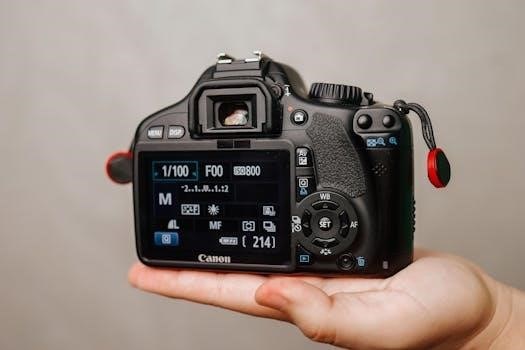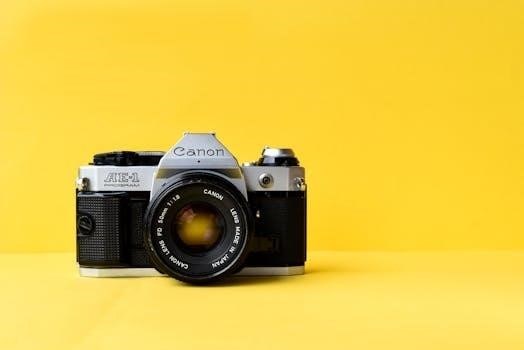
Canon T70 User Manual⁚ An Overview
Welcome to the comprehensive guide for your Canon T70 film camera. This manual will help you navigate through the features and functionalities of this classic SLR. Discover how to utilize its various modes and settings to capture stunning images. It also provides useful tips for troubleshooting.
The Canon T70, a 35mm film SLR camera, made its debut in April 1984, marking a significant step in Canon’s T-series. It is known for its user-friendly design and advanced features for its time. This model aimed to bridge the gap between fully manual cameras and the growing demand for automation in photography. The T70 incorporates electronic controls and a streamlined interface, making it accessible to both amateur and seasoned photographers. Its innovative design includes a top-mounted LCD panel displaying crucial shooting information, a departure from traditional analog SLRs. The camera is powered by readily available AA batteries. Its compatibility with Canon’s FD lens mount provides access to a wide selection of quality optics. The T70’s introduction solidified Canon’s position in the evolving photography market. It offered a blend of ease of use and creative control. This camera represented a progression in the company’s pursuit of photographic excellence. The Canon T70 remains a sought-after camera by film photography enthusiasts today. Its blend of retro charm and functional features makes it a timeless tool for capturing memorable moments. The T70’s legacy continues to inspire new generations of photographers.
Key Features of the Canon T70
The Canon T70 boasts several key features that made it a popular choice among photographers. Its most notable attribute is the top-mounted LCD panel, displaying essential shooting information like shutter speed, aperture, and frame count; The camera features multiple program AE modes, offering different exposure settings for various situations. It includes a dual metering system, allowing for partial and average metering options, providing flexibility in different lighting conditions. The T70 uses an electronic shutter, enabling precise and consistent exposures. It is compatible with Canon’s FD lens mount, granting access to a variety of high-quality lenses. The camera also offers a self-timer mode, perfect for capturing group photos. It is powered by two readily available AA batteries, ensuring ease of use. The built-in film advance motor allows for continuous shooting at a moderate speed. The T70 is designed with user-friendly controls, making it easy to navigate and adjust settings. The camera provides a comfortable grip, suitable for prolonged use. These features collectively provide a versatile and reliable tool for film photography. The Canon T70’s design and functionality continue to make it a favorite among photographers today.
Loading Film into the T70
Loading film into the Canon T70 is a straightforward process, but it is essential to follow the correct steps to avoid any issues. First, ensure the camera is powered off. Open the camera back by gently lifting the rewind knob. Insert a fresh roll of 35mm film into the film chamber, ensuring the film canister is fully seated. Pull the film leader across the camera to the take-up spool, positioning it so that the sprocket teeth engage the film perforations. Gently advance the film using the film advance lever, making sure the film feeds smoothly and correctly onto the take-up spool. Close the camera back until it clicks securely. The camera will automatically advance the film to the first frame. You will usually see the frame counter advance, indicating that the film is correctly loaded. If not, repeat the loading process. Avoid opening the camera back when the film is inside to prevent light exposure. Remember to advance the film a few times before taking the first photo. Proper loading ensures your film is ready for capturing beautiful moments without any problems. Always double-check the film is advancing to prevent wasted shots.
Battery Installation and Replacement
The Canon T70 relies on two AA batteries for its power source, and proper battery installation is crucial for the camera to function correctly. To install or replace the batteries, first locate the battery compartment, usually on the camera’s bottom grip. Open the battery door by sliding or flipping the latch, depending on your specific camera model. Insert the two AA batteries, ensuring they are oriented according to the polarity markings (+ and -) inside the compartment. Incorrect polarity can damage the camera. Once the batteries are in place, close the battery door securely until it clicks shut. After installing fresh batteries, check the LCD display to ensure that the camera is receiving power. If the display remains blank, double-check the battery polarity and that the batteries are not depleted. Always use high-quality alkaline or rechargeable AA batteries for optimal performance. Avoid mixing new and old batteries. When not using the camera for an extended period, remove the batteries to prevent corrosion and potential damage. Regular checks and replacements ensure your T70 is always ready to capture those important moments.

Understanding the Camera Modes
The Canon T70 offers a range of shooting modes to cater to different photographic scenarios. Understanding these modes is key to maximizing your camera’s potential. The primary modes are typically accessed through a dial or buttons on the camera body. The Program mode (P) is an automated mode where the camera selects both aperture and shutter speed based on the light conditions. This is ideal for general shooting and beginners. Aperture Priority (Av) allows you to select the aperture (f-stop), controlling depth of field, while the camera sets the appropriate shutter speed. Shutter Priority (Tv) lets you select the shutter speed to control motion blur, with the camera choosing the aperture. The manual mode (M) gives you full control over both aperture and shutter speed, providing maximum creative flexibility. There are also specialized program modes for specific situations, such as Sports, and Portrait settings. Familiarizing yourself with each mode will enable you to make informed decisions, resulting in more creative and technically sound photographs. Experimenting with all modes is highly recommended to grasp their unique advantages and limitations.
Program Mode Settings
The Program mode (P) on the Canon T70 is designed for ease of use, automatically selecting the optimal aperture and shutter speed based on the available light. While it is automated, it offers some flexibility within its parameters. The camera’s internal light meter assesses the scene and chooses a combination that will produce a well-exposed image. However, this is just a starting point, and the user can make minor adjustments. For instance, the camera may prioritize a faster shutter speed to avoid motion blur in dimly lit scenes, or it may select a narrower aperture for greater depth of field in bright conditions. Even in program mode, you can use the exposure compensation dial to fine-tune the brightness of your images. This is very useful for situations where the camera’s metering might not be accurate, such as high contrast lighting. The program mode also allows you to utilize various flash settings and other camera functions. While it’s automated, understanding how program mode works will significantly improve your photography with the Canon T70. It’s a perfect mode to begin with.
Aperture and Shutter Speed Controls
While the Canon T70 offers automated modes, understanding aperture and shutter speed controls is crucial for creative photography. Aperture, denoted by f-numbers (like f/2.8, f/5.6), controls the amount of light entering the lens and the depth of field. A wider aperture (smaller f-number) allows more light and results in a shallow depth of field, ideal for isolating subjects. A narrower aperture (larger f-number) reduces light and increases depth of field, keeping more of the scene in focus. Shutter speed, measured in seconds or fractions of a second, determines how long the camera’s sensor is exposed to light. Fast shutter speeds (e.g., 1/250, 1/500) freeze motion, while slower speeds (e.g., 1/30, 1/15) can create motion blur. Adjusting these settings allows you to control the exposure and the look of your images. The T70 provides various ways to manage these settings, including manual mode, where you have complete control over both aperture and shutter speed. When used properly, they are powerful tools to create a particular effect in your photographs.

Using the Metering System
The Canon T70 employs a sophisticated metering system to help you achieve proper exposure. This system measures the light in your scene and suggests appropriate aperture and shutter speed combinations. The T70 features a dual metering system, offering both center-weighted average metering and partial metering. Center-weighted average metering considers the entire scene, but gives more emphasis to the center area of the frame. This mode is suitable for most general photography situations. Partial metering, on the other hand, measures light from a small area in the center of the viewfinder. This mode is useful when photographing subjects with complex lighting, such as a backlit subject or when a specific part of the scene needs to be exposed correctly. The meter readings are displayed in the viewfinder, using a combination of lights or numbers. Understanding how to interpret these readings is essential for achieving accurate exposure in your photographs. By carefully using the metering system, you can be sure that your photos are neither too dark nor too bright. The T70’s metering system is a reliable tool to help you get great results.
Flash Photography with the T70
The Canon T70 offers excellent capabilities for flash photography, enhancing your ability to capture well-lit images in low-light conditions. The T70 is compatible with Canon’s dedicated Speedlite flashes, which integrate seamlessly with the camera’s metering system for accurate flash exposure. When using a compatible flash unit, the camera automatically sets the appropriate shutter speed and aperture based on the flash’s power and the subject’s distance. This feature, known as TTL (Through-The-Lens) metering, simplifies flash photography and allows you to focus on composition. The flash charge-completion indicator in the viewfinder signals when the flash is ready to fire. For creative control, you can also use the T70 with manual flash units. In this mode, you’ll need to manually set the aperture and flash power based on your subject distance and desired effect. Keep in mind that the camera’s shutter speed will have to be set to its maximum sync speed to avoid partial images. Remember to check the flash’s manual for specific instructions about its operation. With careful use, flash photography on the T70 can help you create stunning and well-exposed images in various lighting situations.
Troubleshooting Common Issues
Like any mechanical device, the Canon T70 may occasionally encounter issues. If your camera is not powering on, first check the battery compartment for proper installation and consider replacing the batteries with fresh ones. Ensure the battery contacts are clean and free of corrosion. If the film is not advancing, make sure the film is correctly loaded, and that the rewind knob is moving when the film is advanced. If the camera’s meter is not responding correctly, clean the lens contacts and ensure the lens is attached correctly to the camera. Check also the metering mode is appropriate for the lighting conditions. If the shutter is not firing, make sure the camera is not locked and that the shutter release is fully depressed. If the flash is not firing or not syncing properly, ensure the flash is fully charged and compatible with the T70. Consult the flash manual for its operating procedures and contact points. Should you encounter any other issues, referring to the full user manual will provide further guidance on more specific problems. A careful approach to these issues will help you maintain your camera’s functionality and continue taking great pictures.

Accessing the Full User Manual
To gain a thorough understanding of your Canon T70, accessing the full user manual is highly recommended. This comprehensive guide provides detailed explanations of every feature and function, offering invaluable insights into the camera’s capabilities. You can find the complete user manual in PDF format online. Several websites dedicated to vintage cameras and photography enthusiasts offer digital versions of the T70 manual, often as a free download or for a nominal fee. These digital manuals are easily searchable, allowing you to quickly find specific information. Furthermore, some online camera communities and forums may also provide links to user manuals or offer assistance in locating one. If you prefer a physical copy, you can explore online marketplaces where used manuals might be available for purchase. Remember to verify the authenticity of any downloaded manual or sellers before proceeding with a purchase. Having access to the full manual will serve as your primary resource, helping you to fully explore the potential of your Canon T70, enhancing your photography experience.
Where to Find Additional Help and Resources
Beyond the user manual, numerous resources exist to assist Canon T70 users. Online photography forums and communities, especially those focused on vintage cameras, are excellent places to ask questions and share experiences. These platforms often have knowledgeable members who can offer advice and solutions to common issues. Websites dedicated to camera repair sometimes provide service manuals, which can be useful for understanding the inner workings of the T70. Additionally, video-sharing platforms like YouTube host tutorials and reviews of the T70, offering visual guidance on its operation. Exploring online marketplaces may reveal sellers who offer original manuals or replacement parts for the camera. Social media groups dedicated to film photography can also be a source of tips and techniques. Remember to exercise caution when downloading files or purchasing from unfamiliar sources. Always check the credibility of resources before relying on the information. By utilizing a combination of these resources, you can significantly enhance your knowledge and enjoyment of your Canon T70, further developing your photographic skills.